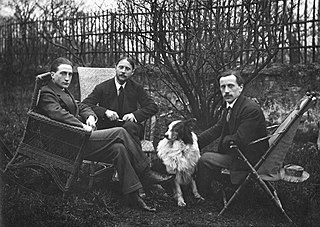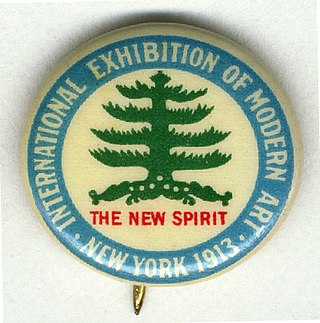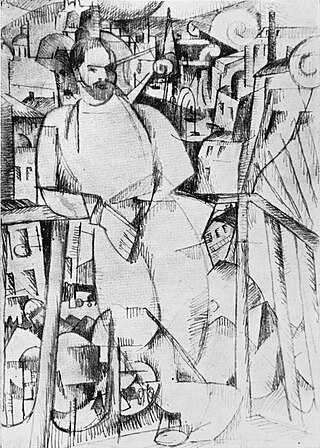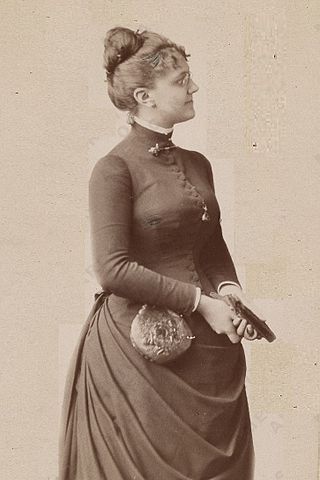
Jacques Villon, also known as Gaston Duchamp, was a French Cubist and abstract painter and printmaker.

Jean Dominique Antony Metzinger was a major 20th-century French painter, theorist, writer, critic and poet, who along with Albert Gleizes wrote the first theoretical work on Cubism. His earliest works, from 1900 to 1904, were influenced by the neo-Impressionism of Georges Seurat and Henri-Edmond Cross. Between 1904 and 1907, Metzinger worked in the Divisionist and Fauvist styles with a strong Cézannian component, leading to some of the first proto-Cubist works.

Robert Delaunay was a French artist of the School of Paris movement; who, with his wife Sonia Delaunay and others, co-founded the Orphism art movement, noted for its use of strong colours and geometric shapes. His later works were more abstract. His key influence related to bold use of colour and a clear love of experimentation with both depth and tone.

The 1913 Armory Show, also known as the International Exhibition of Modern Art, was organized by the Association of American Painters and Sculptors. It was the first large exhibition of modern art in America, as well as one of the many exhibitions that have been held in the vast spaces of U.S. National Guard armories.

William Crapo Durant was a leading pioneer of the United States automobile industry and co-founder of General Motors and Chevrolet. He created a system in which a company held multiple marques – each seemingly independent, with different automobile lines – bound under a unified corporate holding company. Durant, along with Frederic L. Smith, co-founded General Motors, as well as Chevrolet with Louis Chevrolet. He also founded Frigidaire.

Orphism or Orphic Cubism, a term coined by the French poet Guillaume Apollinaire in 1912, was an offshoot of Cubism that focused on pure abstraction and bright colors, influenced by Fauvism, the theoretical writings of Paul Signac, Charles Henry and the dye chemist Michel Eugène Chevreul. This movement, perceived as key in the transition from Cubism to Abstract art, was pioneered by František Kupka, Robert Delaunay and Sonia Delaunay, who relaunched the use of color during the monochromatic phase of Cubism. The meaning of the term Orphism was elusive when it first appeared and remains to some extent vague.

Synchromism was an art movement founded in 1912 by American artists Stanton Macdonald-Wright (1890–1973) and Morgan Russell (1886–1953). Their abstract "synchromies," based on an approach to painting that analogized color to music, were among the first abstract paintings in American art. Though it was short-lived and did not attract many adherents, Synchromism became the first American avant-garde art movement to receive international attention. One of the difficulties inherent in describing Synchromism as a coherent style is connected to the fact that some Synchromist works are purely abstract while others include representational imagery.

Arthur Bowen Davies was an avant-garde American artist and influential advocate of modern art in the United States c. 1910–1928.

John Quinn was an Irish-American cognoscente of the art world and a lawyer in New York City who fought to overturn censorship laws restricting modern literature and art from entering the United States.

Henry Howland Crapo was a businessman and politician who was the 14th governor of Michigan from 1865 to 1869, during the end of the American Civil War and the beginning of Reconstruction.

Manierre Dawson was an abstract American painter and sculptor.

Edward Middleton Manigault was a Canadian-born American Modernist painter.
Jerome Eddy was a Michigan businessman, politician and diplomat. He served on the Democratic Michigan State Central Committee and was a delegate to many Democratic State Conventions. During the Grover Cleveland Presidency, he served as a United States Consul in Canada.

Cubist sculpture developed in parallel with Cubist painting, beginning in Paris around 1909 with its proto-Cubist phase, and evolving through the early 1920s. Just as Cubist painting, Cubist sculpture is rooted in Paul Cézanne's reduction of painted objects into component planes and geometric solids; cubes, spheres, cylinders, and cones. Presenting fragments and facets of objects that could be visually interpreted in different ways had the effect of 'revealing the structure' of the object. Cubist sculpture essentially is the dynamic rendering of three-dimensional objects in the language of non-Euclidean geometry by shifting viewpoints of volume or mass in terms of spherical, flat and hyperbolic surfaces.

Modern sculpture is generally considered to have begun with the work of Auguste Rodin, who is seen as the progenitor of modern sculpture. While Rodin did not set out to rebel against the past, he created a new way of building his works. He "dissolved the hard outline of contemporary Neo-Greek academicism, and thereby created a vital synthesis of opacity and transparency, volume and void". Along with a few other artists in the late 19th century who experimented with new artistic visions in sculpture like Edgar Degas and Paul Gauguin, Rodin invented a radical new approach in the creation of sculpture. Modern sculpture, along with all modern art, "arose as part of Western society's attempt to come to terms with the urban, industrial and secular society that emerged during the nineteenth century".

Man on a Balcony, is a large oil painting created in 1912 by the French artist, theorist and writer Albert Gleizes (1881–1953). The painting was exhibited in Paris at the Salon d'Automne of 1912. The Cubist contribution to the salon created a controversy in the French Parliament about the use of public funds to provide the venue for such 'barbaric art'. Gleizes was a founder of Cubism, and demonstrates the principles of the movement in this monumental painting with its projecting planes and fragmented lines. The large size of the painting reflects Gleizes's ambition to show it in the large annual salon exhibitions in Paris, where he was able with others of his entourage to bring Cubism to wider audiences.

Woman with Phlox is an oil painting created in 1910 by the French artist Albert Gleizes. The painting was exhibited in Room 41 at the Salon des Indépendants in the Spring of 1911 ; the exhibition that introduced Cubism as a group manifestation to the general public for the first time. The complex collection of geometric masses in restrained colors exhibited in Room 41 created a scandal from which Cubism spread throughout Paris, France, Europe and the rest of the world. It was from the preview of the works by Gleizes, Jean Metzinger, Henri Le Fauconnier, Robert Delaunay, and Fernand Léger at the 1911 Indépendants that the term 'Cubism' can be dated. La Femme aux Phlox was again exhibited the following year at the Salon de la Section d'Or, Galerie La Boétie, 1912. La Femme aux Phlox was reproduced in The Cubist Painters, Aesthetic Meditations by Guillaume Apollinaire, published in 1913. The same year, the painting was again revealed to the general public, this time in the United States, at the International Exhibition of Modern Art, New York, Chicago, and Boston. The work is now in the Museum of Fine Arts, Houston, Gift of the Esther Florence Whinery Goodrich Foundation in 1965.

Groupe de femmes, also called Groupe de trois femmes, or Groupe de trois personnages, is an early Cubist sculpture created circa 1911 by the Hungarian avant-garde, sculptor, and graphic artist Joseph Csaky (1888–1971). This sculpture formerly known from a black and white photograph had been erroneously entitled Deux Femmes , as the image captured on an angle showed only two figures. An additional photograph found in the Csaky family archives shows a frontal view of the work, revealing three figures rather than two. Csaky's sculpture was exhibited at the 1912 Salon d'Automne, and the 1913 Salon des Indépendants, Paris. A photograph taken of Salle XI in sitiu at the 1912 Salon d'Automne and published in L'Illustration, 12 October 1912, p. 47, shows Groupe de femmes exhibited alongside the works of Jean Metzinger, František Kupka, Francis Picabia, Amedeo Modigliani and Henri Le Fauconnier.

Henrietta (Letta) Crapo Smith was a painter, known as a color specialist and granddaughter of the former Michigan Governor, Henry H. Crapo.

Improvisation No. 30 (Cannons) is an oil painting executed between 1911 and 1913 by the abstract painter Vasily Kandinsky. The work was donated by the Chicago lawyer Arthur Jerome Eddy to the Art Institute of Chicago, in whose permanent collection it still remains.























